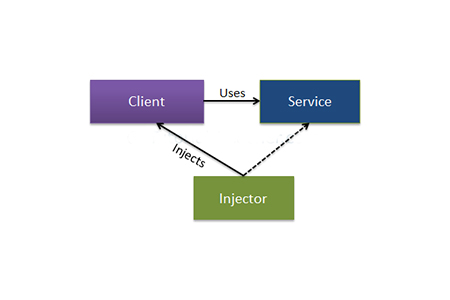What is dependency injection
Dependency injection is a design pattern that implements inversion of control and solves dependency problems. It has three types: constructor injection, property injection and method injection. It has benefits such as reducing dependencies and enhancing the reusability of components
Dependency injection (DI) is a design pattern that eliminates dependencies between programming codes, so applications can be easily managed and tested program. Next, in the article, we will introduce in detail what dependency injection is, which has a certain reference effect. I hope it will be helpful to everyone

[Recommended courses:Spring Tutorial】
Dependency Injection:
In programming, dependency injection It is a design pattern that implements inversion of control and is used to solve dependency problems. A dependency refers to an object that can be exploited. Dependency injection is passing dependencies to dependent objects to be used. The service will become part of the client's state and pass the service to the client without allowing the client to create or find the service. Dependency injection makes our programming code loosely coupled and easy to manage

Types of dependency injection:
The injected class will serve (Dependencies) Injection into the client (dependencies) can be divided into the following forms
(1) Constructor injection: In constructor injection, the injector provides services (dependencies) through the client class constructor ).
(2) Property injection: In property injection (also known as Setter injection), the injector provides dependencies through public properties of the client class.
(3) Method injection: In this type of injection, the client class implements an interface that declares methods to provide dependencies, and the injector uses this interface to provide dependencies on the client class sex.
Benefits of dependency injection:
(1) Reduce dependencies
Dependency injection can eliminate or reduce the inconsistencies between components Necessary dependencies. To reduce the impact of component changes Component
(2) Enhance reusability
Reducing component dependencies can enhance component Reusability. If a different implementation of an interface is required in a different context, or just a different configuration of the same implementation, the component can be configured to use that implementation. No code changes required.
(3) Increase the testability of the code
Dependency injection also increases the testability of the component. When dependencies can be injected into a component, it means that mock implementations of those dependencies can be injected. Mock objects are used for testing as a substitute for the actual implementation, and the behavior of the mock objects can be configured
(4) Enhance the readability of the code
Dependency injection can convert dependencies The item is moved to the component's interface. Makes it easier to see which components have dependencies, making the code more readable.
(5)Reduce dependency bearing
Dependency bearing can create a lot of "noise" in the code, making it difficult to read and maintain , and makes the component harder to test. Dependency injection can reduce dependency bearing and the use of static singletons, and can perfectly connect components together
Summary: The above is the entire content of this article, I hope it will be helpful to everyone
The above is the detailed content of What is dependency injection. For more information, please follow other related articles on the PHP Chinese website!

Hot AI Tools

Undresser.AI Undress
AI-powered app for creating realistic nude photos

AI Clothes Remover
Online AI tool for removing clothes from photos.

Undress AI Tool
Undress images for free

Clothoff.io
AI clothes remover

Video Face Swap
Swap faces in any video effortlessly with our completely free AI face swap tool!

Hot Article

Hot Tools

Notepad++7.3.1
Easy-to-use and free code editor

SublimeText3 Chinese version
Chinese version, very easy to use

Zend Studio 13.0.1
Powerful PHP integrated development environment

Dreamweaver CS6
Visual web development tools

SublimeText3 Mac version
God-level code editing software (SublimeText3)

Hot Topics
 A step-by-step guide to understanding dependency injection in Angular
Dec 02, 2022 pm 09:14 PM
A step-by-step guide to understanding dependency injection in Angular
Dec 02, 2022 pm 09:14 PM
This article will take you through dependency injection, introduce the problems that dependency injection solves and its native writing method, and talk about Angular's dependency injection framework. I hope it will be helpful to you!
 How to use dependency injection (Dependency Injection) in the Phalcon framework
Jul 30, 2023 pm 09:03 PM
How to use dependency injection (Dependency Injection) in the Phalcon framework
Jul 30, 2023 pm 09:03 PM
Introduction to the method of using dependency injection (DependencyInjection) in the Phalcon framework: In modern software development, dependency injection (DependencyInjection) is a common design pattern aimed at improving the maintainability and testability of the code. As a fast and low-cost PHP framework, the Phalcon framework also supports the use of dependency injection to manage and organize application dependencies. This article will introduce you how to use the Phalcon framework
 Dependency injection pattern in Golang function parameter passing
Apr 14, 2024 am 10:15 AM
Dependency injection pattern in Golang function parameter passing
Apr 14, 2024 am 10:15 AM
In Go, the dependency injection (DI) mode is implemented through function parameter passing, including value passing and pointer passing. In the DI pattern, dependencies are usually passed as pointers to improve decoupling, reduce lock contention, and support testability. By using pointers, the function is decoupled from the concrete implementation because it only depends on the interface type. Pointer passing also reduces the overhead of passing large objects, thereby reducing lock contention. Additionally, DI pattern makes it easy to write unit tests for functions using DI pattern since dependencies can be easily mocked.
 Dependency injection using JUnit unit testing framework
Apr 19, 2024 am 08:42 AM
Dependency injection using JUnit unit testing framework
Apr 19, 2024 am 08:42 AM
For testing dependency injection using JUnit, the summary is as follows: Use mock objects to create dependencies: @Mock annotation can create mock objects of dependencies. Set test data: The @Before method runs before each test method and is used to set test data. Configure mock behavior: The Mockito.when() method configures the expected behavior of the mock object. Verify results: assertEquals() asserts to check whether the actual results match the expected values. Practical application: You can use a dependency injection framework (such as Spring Framework) to inject dependencies, and verify the correctness of the injection and the normal operation of the code through JUnit unit testing.
 Go Language: Dependency Injection Guide
Apr 07, 2024 pm 12:33 PM
Go Language: Dependency Injection Guide
Apr 07, 2024 pm 12:33 PM
Answer: In Go language, dependency injection can be implemented through interfaces and structures. Define an interface that describes the behavior of dependencies. Create a structure that implements this interface. Inject dependencies through interfaces as parameters in functions. Allows easy replacement of dependencies in testing or different scenarios.
 Explain the concept of Dependency Injection (DI) in PHP.
Apr 05, 2025 am 12:07 AM
Explain the concept of Dependency Injection (DI) in PHP.
Apr 05, 2025 am 12:07 AM
The core value of using dependency injection (DI) in PHP lies in the implementation of a loosely coupled system architecture. DI reduces direct dependencies between classes by providing dependencies externally, improving code testability and flexibility. When using DI, you can inject dependencies through constructors, set-point methods, or interfaces, and manage object lifecycles and dependencies in combination with IoC containers.
 How to use dependency injection for unit testing in Golang?
Jun 02, 2024 pm 08:41 PM
How to use dependency injection for unit testing in Golang?
Jun 02, 2024 pm 08:41 PM
Using dependency injection (DI) in Golang unit testing can isolate the code to be tested, simplifying test setup and maintenance. Popular DI libraries include wire and go-inject, which can generate dependency stubs or mocks for testing. The steps of DI testing include setting dependencies, setting up test cases and asserting results. An example of using DI to test an HTTP request handling function shows how easy it is to isolate and test code without actual dependencies or communication.
 Dependency injection and service container for PHP functions
Apr 27, 2024 pm 01:39 PM
Dependency injection and service container for PHP functions
Apr 27, 2024 pm 01:39 PM
Answer: Dependency injection and service containers in PHP help to flexibly manage dependencies and improve code testability. Dependency injection: Pass dependencies through the container to avoid direct creation within the function, improving flexibility. Service container: stores dependency instances for easy access in the program, further enhancing loose coupling. Practical case: The sample application demonstrates the practical application of dependency injection and service containers, injecting dependencies into the controller, reflecting the advantages of loose coupling.





